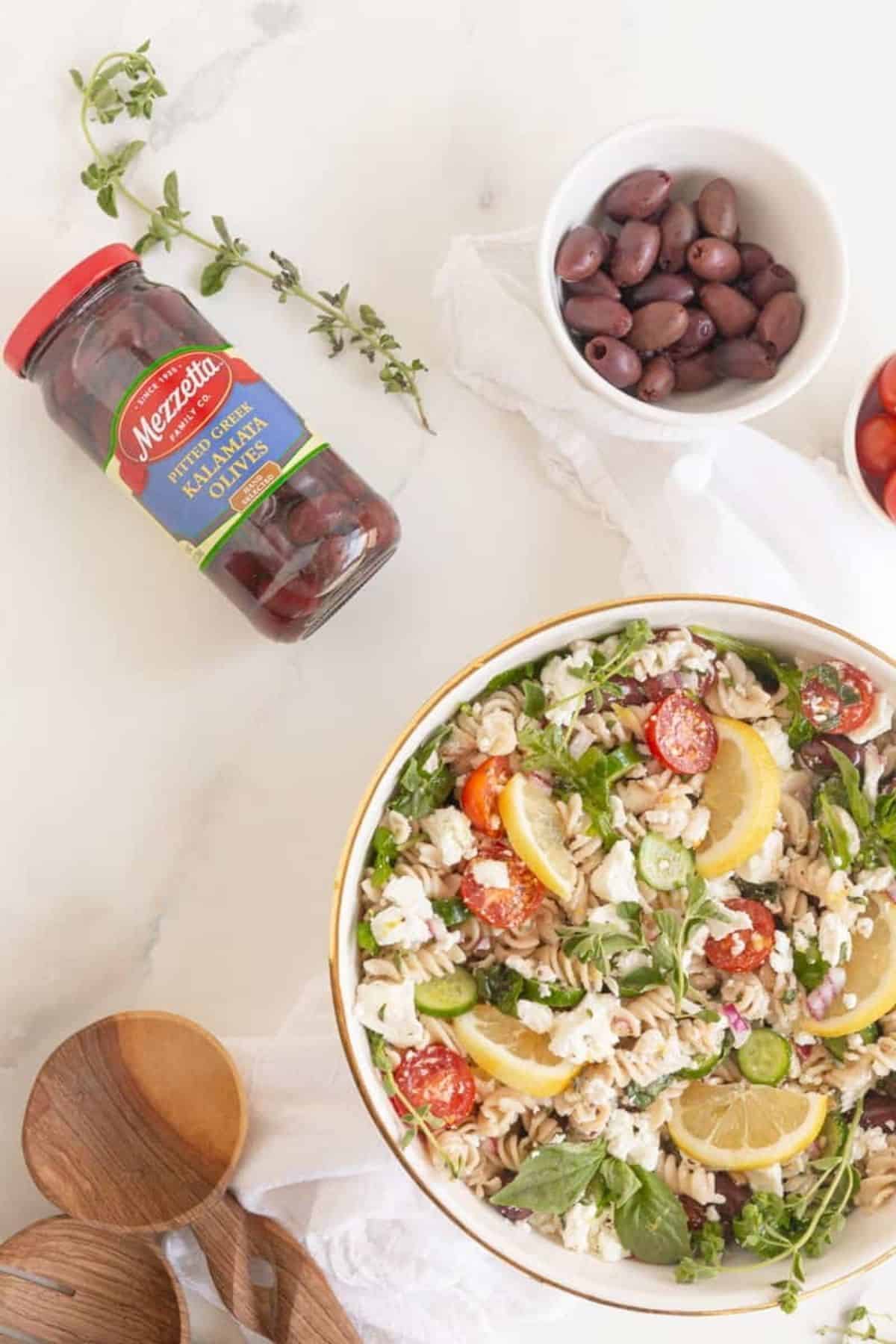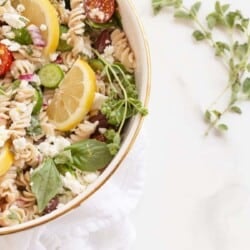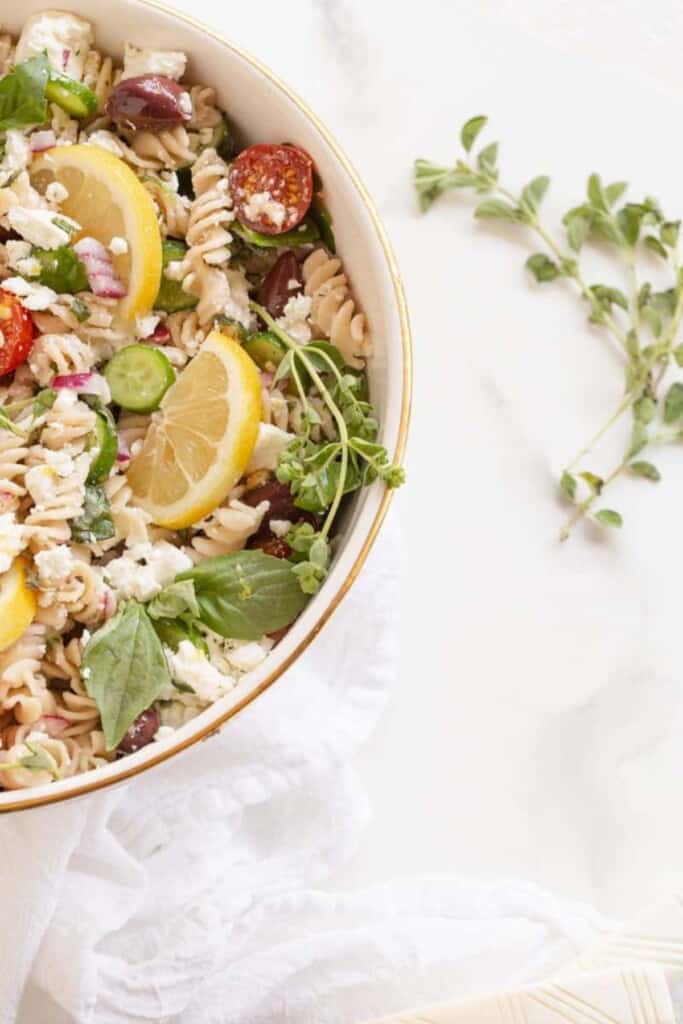Pasta salad is like half of my summer diet. The other half being fresh fruit and ice cream. I don't mind that diet. I just love to make a big batch of pasta salad and having it ready to go for lunch time. And I'm using Mezzetta olives to make this delicious recipe.
I am a big fan of Mezzetta and all of their products. I am personally a big lover of olives and pickled peppers. Put them in a pasta, on a pizza, on a snacking tray, or really anywhere, and I am all over it. As a kid, I would come home from school and eat olives from a jar and string cheese...I don't think that's most kids snack time, but it was my favorite.
This post has been sponsored by Mezzetta. All thoughts and opinions are my own.
Some of my other favorite salads include Blackened Salmon Salad and Spring Mix Salad with Cilantro Parmesan Vinaigrette and Chicken.
This pasta salad is perfect for a picnic, parties, or just as your lunch for the week. It's easy to make in advance and keep in the fridge for up to a week. Then you can eat the leftover olives as snacks or on cheese boards! And I use the left over cucumbers and tomatoes as hummus board snacks or on salads.
I use these and other quality ingredients in this recipe. You can read more about certain ingredients below.

Table of Contents

Tips on Ingredients
Usually the better the ingredients, the better your food will taste. However, I do like to go over some details about each ingredient, what's best to get high quality, what special things to look for, what things can't be substituted and more. Not all items will have notes for this pasta salad.
- Olive Oil: Olive oil is something I learned a lot about on a trip to Israel where we went to an olive farm and learned all about the process. A few quick tips for anyone looking to buy olive oil. Don't buy anything in a clear glass bottle. Something in a dark bottle or completely opaque is best. Fresh olive oil is better, so look at the date of bottling and/or expiration. Read the labels, whether it's for extra virgin olive oil, the process, or the expiration date, you want to know the details. Also, use a household name, it is usually a good bet.
- Herbs: I prefer fresh herbs, especially in summer when our little potted herbs are growing wild. But you can definitely use dried if that is what you have in your house.
- Garlic: I use a powder in the dressing to make sure it's evenly distributed, but you can 100% use fresh garlic.
- Pasta: I love using fusilli pasta for pasta salad, but you can also use a tubular pasta like penne for this.
- Olives: I used Mezzetta Pitted Kalamata Olives, you could also use their green olives, but I personally love Kalamata olives above all others and think they go perfectly in this pasta salad.
- Arugula: You can easily swap this for spinach or kale, but arugula has the best flavor profile and mouth feel for this recipe.
- Pasta Salad Add-ins: You could mix these up to your preferences, just remember that the recipe calls for these as the standard and mixing things up will change the flavor profile.
- Feta: I like to use a block of feta so you can crumble it up as you'd like and have some smaller and larger pieces as you please.

Expert Tips
These tips are helpful for when you are making the recipe. Outside of the tips for ingredients above, these are tips on how to do something or why what I have listed in the recipe is necessary.
- Dressing: This dressing is great for pasta salad, but also delicious for salads or dipping veggies. You can make this in a larger batch by doubling the recipe and storing in a mason jar in the fridge for at least one week or so.
- Acid in Dressing: I use both the lemon juice (and zest) and the white wine vinegar for a nice balance. However, if you only have one in your house you can definitely just use that instead in the same amounts as listed for the other.
- Alternatives: This salad can be made with a lot of swaps, but I do want to repeat that any swaps you make will ultimately change the flavor of the salad and therefore it is not the recipe I am providing you with, so if something tastes wrong with the alternatives...that is due to the swapping. Some easy swaps would be the type of pasta, using just one acid, dried herbs instead of fresh, etc.
- Assembling: Assembling is the easiest part. You just toss it all together in a large bowl. However, for presentation you might want to put aside a little bit of the cheese, some herbs, and lemon slices for topping and making the presentation beautiful.

FAQs
You want a pasta type that is going to hold onto the dressing. I would recommend a rotini, elbow (macaroni), any tubular pasta. This will be ideal in holding in all the delicious dressing/sauce for this. I would recommend smaller sized tubular pastas for a pasta salad however. Some of my favorite smaller tubular pastas include: penne, elbow, pipe rigate, and tubetti.
To easily cut the cherry tomatoes, you can do them each individually. Or you can place a handful of cherry tomatoes on a flat cutting board, all right next to one another. Place a flat bottom plate or tupperware top on top of the tomatoes. Place your hand on top of the plate/tupperware to hold tomatoes in place (not too tightly or they will burst). Then using a long knife, slice the tomatoes in half by cutting through the opening between the plate/tupperware and the cutting board. Voila! You have halved cherry tomatoes.
You can easily swap out the arugula for chopped or whole spinach. I love the flavor the arugula adds to this dish, but spinach can also add a wonder flavor and nutrients to the dish. You can swap it cup for cup in this instance.
The biggest difference between feta and goat cheese is what they are made of and their flavor/texture. Feta is a greek cheese made from sheep or sheep and goats milk. It's brined usually in blocks with oil and herbs. It's salty, tangy, and usually a harder consistency than goat cheese.
Goat cheese is made with strictly goat's milk. It can be made in a variety of ways, flavors, and consistency, but tends to run softer and smoother than feta. Goat cheese typically has a consistency where you could spread it across toast or crackers. It is also a bit tart in flavor, but usually a bit more subtle.
Both sheep and goat milk (therefore cheese) has less lactose in it and is easier for humans to digest. Note: hard goat cheeses do exist of course, but in comparing feta a goat cheese, we are typically talking about soft goat cheese.

Other Recipes to Try
- Spring Mix Salad with Cilantro Parmesan Vinaigrette and Chicken
- Spicy Watermelon Salad
- Spinach Turkey Lasagna
Love this Recipe?
Did you make this recipe and just love it? Awesome! If you have a quick minute and could leave a star rating and comment below, I would appreciate the support and knowing your feedback! And if you’re over on Instagram, be sure to tag me in your photos!

Ingredients
Dressing Ingredients
- 1 ½ cup Olive Oil
- 2 tablespoon white wine vinegar
- ½ lemon juiced and zested
- 2 tablespoon oregano fresh and chopped (6-8 sprigs)
- 2 tablespoon basil fresh and chopped (8-10 large leaves)
- 1 teaspoon Garlic powder
- ½ teaspoon dill dried
- Dash of salt and pepper
Pasta Salad Ingredients
- 1 lb. fusilli pasta
- 1-2 tablespoon olive oil
- ½ cup kalamata olives
- 1 cup cucumbers sliced
- 1 cup cherry tomatoes halved
- 2 cups arugula loosely packed
- ¼ cup red onion finely chopped
- 8 oz feta cheese
- ½ lemon sliced, optional
- fresh herbs optional for garnishing dish
Instructions
Dressing Instructions
- Take all ingredients and place into a bowl or jar. Mix well. Can be kept in the fridge
Pasta Salad Instructions
- Cook pasta according to the instructions on the package. Drain and toss pasta in a large bowl with olive oil.
- Add in pitted kalamata olives, cucumbers, tomatoes, arugula, red onion, feta, and dressing. Toss well.
- Pour into a large serving bowl. Top with lemon slices and herbs.

Whitney says
Who doesn't love pasta salad? And all these yummy toppings?
wilensamanda says
Yes! Toppings are most important.